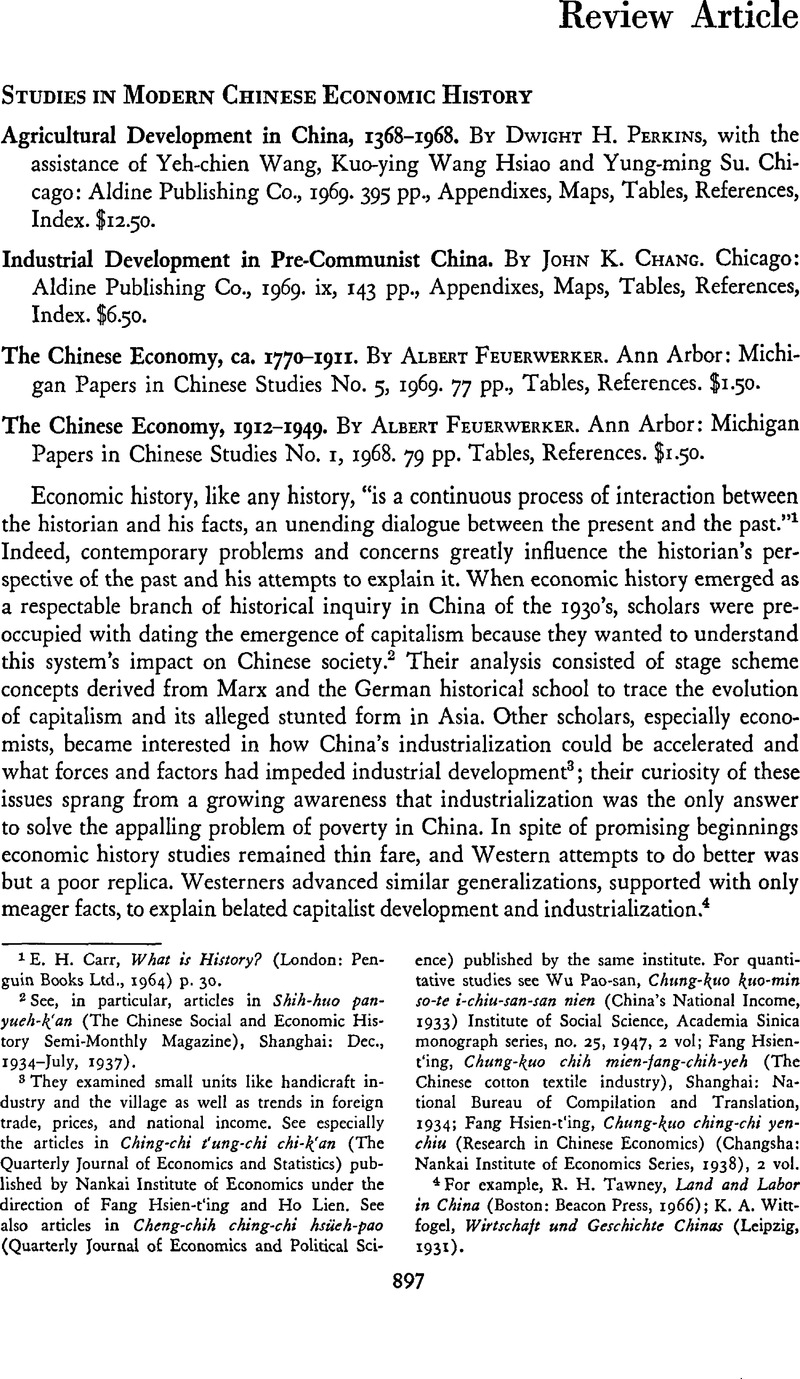Published online by Cambridge University Press: 23 March 2011

1 Carr, E. H., What is History? (London: Penguin Books Ltd., 1964) p. 30.Google Scholar
2 See, in particular, articles in Shih-huo panyueh-k'an (The Chinese Social and Economic History Semi-Monthly Magazine), Shanghai: 12, 1934–07, 1937).Google Scholar
3 They examined small units like handicraft industry and the village as well as trends in foreign trade, prices, and national income. See especially the articles in Ching-chi t'ung-chi chi-k'an (The Quarterly Journal of Economics and Statistics) published by Nankai Institute of Economics under the direction of Fang Hsien-t'ing and Ho Lien. See also articles in Cheng-chih ching-chi hsüeh-pao (Quarterly Journal of Economics and Political Science) published by the same institute. For quantitative studies see Pao-san, Wu, Chung-kuo kuo-min so-te i-chiu-san-san nien (China's National Income, 1933)Google Scholar Institute of Social Science, Academia Sinica monograph series, no. 25, 1947, 2 vol; Hsien-t'ing, Fang, Chung-kuo chih mien-fang-chih-yeh (The Chinese cotton textile industry), Shanghai: National Bureau of Compilation and Translation, 1934Google Scholar; Hsien-t'ing, Fang, Chung-kuo ching-chi yenchiu (Research in Chinese Economics) (Changsha: Nankai Institute of Economics Series, 1938), 2 vol.Google Scholar
4 For example, Tawney, R. H., Land and Labor in China (Boston: Beacon Press, 1966)Google Scholar; Wittfogel, K. A., Wirtschaft und Geschichte Chinas (Leipzig, 1931).Google Scholar
5 Gould, J. D., “Hypothetical History,” The Economic History Review, Second Series, 22:2, 1969, p. 195.Google Scholar
6 Dwight H. Perkins, pp. 29–35.Google Scholar
7 To be sure, Perkins mentions that other alternative estimates are possible, and he proceeds to give an unlikely estimate of grain yield (p. 17). But I think his case could have been made even more convincing had he constructed several tables showing a range of realistic grain yield estimates based on the various probable values of per capita grain consumption, cultivated area for grain, and population. It is also interesting to speculate whether increased cultivation in nongrain crops after 1910 would have required adjusting his 80 percent of area planted to grain downward to obtain a 1933 grain yield estimate.
8 John K. Chang, pp. 124–27.Google Scholar
9 Ibid., pp. 60–61.
10 Gerschenkron, Alexander, Economic Backwardness in Historical Perspective (New York: Praeger, 1962), p. 129 and 202Google Scholar. Even Indian industrial out-put increased fairly rapidly after 1900. Between 1900 and 1935 production expanded at a 3.6 percent growth rate per annum, and between 1935 and 1952 a slight acceleration to 4.5 percent per annum occurred. The quality of these series and indices is questionable. See Mukerji, Kshitimohon, Levels of Economic Activity and Public Expenditure in India: A Historical and Quantitative Study, (Bombay: Asia Publishing House, 1965), Table 4, p. 88.Google Scholar
11 Deane, Phillis and Cole, W. A., British Economic Growth; 1688–1959: Trends and Structure (Cambridge: Cambridge University Press, 1962), p. 78.Google Scholar
12 Walther G. Hoffman (tr. by W. O. Henderson and W. H. Chalone), British Industry: 1700–1950 (New York: Kelley and Millman, Inc., 1955) p. 207.Google Scholar
13 Frickey, Edwin, Production in the United States (Cambridge: Harvard University Press, 1947) p. 66.Google Scholar
14 Yasukichi, Yasuba, “Nihon no kōgyō seisan shisū, 1905–1935 nen” (Industrial Production Index for Japan; 1905–1935)Google Scholar in Kenichi, Inada and Tadao, Uchida (edit.), Keizai seichö no riron to keisoku (Theory and Measurement of Economic Growth) (Tokyo: Iwanami Shoten, 1966) p. 283.Google Scholar
15 The Chinese Economy ca. 1870–1911, p. 28.Google Scholar
16 Ibid., p. 36.
17 The rather unusual relationship between handicraft and factory textile production has been explored in some length by Myers, Ramon H., “Cotton Textile Handicraft and the Development of the Cotton Textile Industry in Modern China,” The Economic History Review, Second Series, 18:3, 1965, pp. 614–32CrossRefGoogle Scholar. This essay compares the growth of factory and machine produced cloth in China and Japan. It suggests that Japanese entrepreneurs were fortunate to wrest the home market away from handicraft cloth producers by earning huge profits from yarn exports which enabled them to modernize machine weaving and reduce unit cost of production. Chinese factory entrepreneurs, on the other hand, were not as fortunate to develop yarn export markets, and securing the home market for machine made cloth was a more difficult and time consuming process.
18 An excellent account of the voluminous research and materials produced by Japanese scholarship in the early period of their administration of Taiwan can be found in Rinji Taiwan Kyūkan chōsakai (The Provisional Commission for the Survey of Old Taiwan Customs), Taiwan kyūkan chōsa jigyō hōkoku (A Report of the Research Undertaking on Old Taiwan Customs) (Taipei, 1917), 129 pp.Google Scholar
19 This approach requires examining mercantile customs and practices from the social and legal aspects of business operations. A beginning in the right direction can commence when we examine the extensive pre-war studies of commercial property and enterprise organization undertaken by the Japanese. In this respect, see materials relating to commercial and private property use and exchange in kenkyūjo, Tōa, Shina kankō chōsa kōmoku (Items Surveyed in the Investigation of Chinese Customs) (Tokyo, 1941), 14 pp.Google Scholar
20 An excellent approach to do this has been set forth in Homans, George C., The Nature of Social Sciences, (New York: Harcourt, Brace and World, Inc., 1967) pp. 21–31.Google Scholar